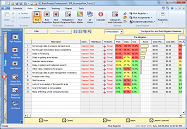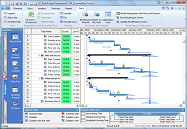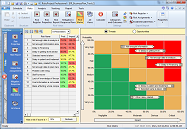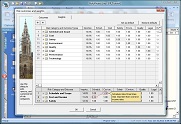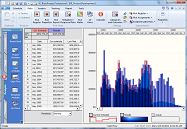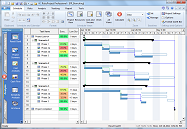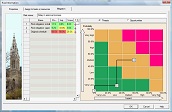
New Features of RiskyProject 3.1
RiskyProject Professional:
Advanced Project
Risk Analysis
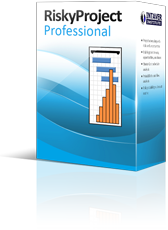
RiskyProject Lite:
Introduction to Project Risk Analysis
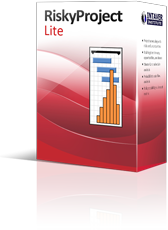
Here are some of RiskyProject clients:
-
Non-schedule risks and user-defined risks outcomes.
RiskyProject 3 performs quantitative risk analysis on any types of risks outcomes including non-schedule risks. Non-schedule risk are risks that are not related to the project schedule (affect cost or duration), but can have an effect on overall project success such as quality, safety, performance, etc. Previous versions of RiskyProject performed analysis only with limited set of predefined risks outcomes: delay, cost increase, cancel task, etc.
You can now rank risks of all types based on scores. Risks affecting quality, safety, technology, project duration, cost, and others can be ranked together. In addition, for non-schedule risks (quality, safety, etc.), you do not necessarily need a project schedule to perform analysis.
-
Risk register and issue management.
A risk register is a set of all risks and issues in the project. Issues are risks that have occurred and therefore are having an actual affect on your project. You can easily convert risks to issues. You can open and close risks. Risks in the risk register may have different properties. You may define any properties for all projects. Among the properties available are owner, recorder, contact, date recorded, date converted to issue, location, etc. Risks and issues are fully searchable based on risk properties.
The risk register presents calculated risk impact, risk probability and risk score, which is equal probability multiplied on impact. The risk register also shows probability, calculated impact and score of the risk after mitigation.
The risk register can be exported and used for other projects.
-
Improved integration with Microsoft® Project and other project management applications.
RiskyProject has greatly improved its integration with project schedules created in from Microsoft Project, Oracle® Primavera, and other project management software. In RiskyProject 3, schedules imported from this software will be fully compatible with original schedule. In few very specific cases, there will be small differences between your original schedule and the one in RiskyProject due to the probabilistic nature of RiskyProject.
-
Event chain diagrams and improved risk assignment interfaces.
Risks and issues can be shown on the Gantt chart as arrows. The calculated impact of a risk is color-coded. For threats green = low, yellow = medium, and red = high. For opportunities, colors are opposite. If a risk has both threats and opportunities, the color is not defined. The size of the arrow represents the risk probability. Click on an arrow to view information about the particular risk. RiskyProject 3 has also significantly eased risk assignment. With the Risk Register, you can assign all risks (local or global) to the project schedule.
-
Risk Matrix.
The Risk matrix shows project risks' impact and probabilities and allows you to identify critical risks. In addition, the Risk matrix shows both threats and opportunities. The Risk Matrix is fully customizable: you can define the size of the matrix and risk attitude.
-
Cash Flow Analysis.
You can now view a project cash flow. The Cash flow analysis view shows monthly, bi-monthly, quarterly, and yearly cost and income allocation. You can also apply Net Present Value (NPV) discount rates and internal rate of return (IRR).
-
Probabilistic Work Management.
You can now define and calculate probabilistic work management for different resources in RiskyProject 3. The result of this analysis includes statistical distribution of work for complete projects and each resource.
-
Multiple Baselines.
RiskyProject now supports multiple baselines. You can save the current schedule or the calculated results as a baseline. A baseline is a deterministic project schedule, which you can use to:
- Track project performance against the baseline
- Analyze different project scenarios
- Perform mitigation analysis. For example, if you want to understand effect of mitigation efforts for a group of risks on project cost. To compare pre and post mitigation schedules, you perform an analysis with and without mitigation efforts and save the results as different baselines.
-
Probabilistic Calendar and Calendar improvements.
You can now model weather and other calendar related event's using probabilistic calendars. If your project has a 30% chance of running an inclement weather schedule, you can create this calendar with reduced hours of operation and run it 30% of the time during the project to model this calendar risk. In addition, RiskyProject 3 now has calendars that are associated with particular resources and tasks.
-
Setting low/high cost and duration for a group of tasks.
You can now quickly define low and high cost or duration estimates for either a selected group of tasks or the entire project. Just select a group of tasks (or the project) and define the coefficients or values that you want to use to calculate low and high duration and cost. RiskyProject will automatically update all of the selected tasks.
-
Showing results for a specific percentile.
You can now show low and high results based on custom percentiles. For example, you may be required to manage or report on a certainty level of 70 percentile. Simply change the high results to 70 percentile and views will now reflect this setting.
-
Improved Probabilistic and Conditional Branching.
Branching performance has been significantly improved. Tasks with branches are clearly indicated on the Gantt chart for easy identification. Additional branching actions have been added.
-
Improved Interface.
RiskyProject 3 has a new look with larger easier to read icons and themes that you can easily modify. The Workflow bar has been updated to separate the risk workflow from the scheduling activities and a Risk menu has been added to the main toolbar.
RiskyProject 3.1 can be installed together with previous versions of RiskyProject (uninstall does not required). All current users of RiskyProject 2.x can upgrade the software free of charge. If you are the user of RiskyProject 1.x please contact Intaver Institute for the upgrade.

